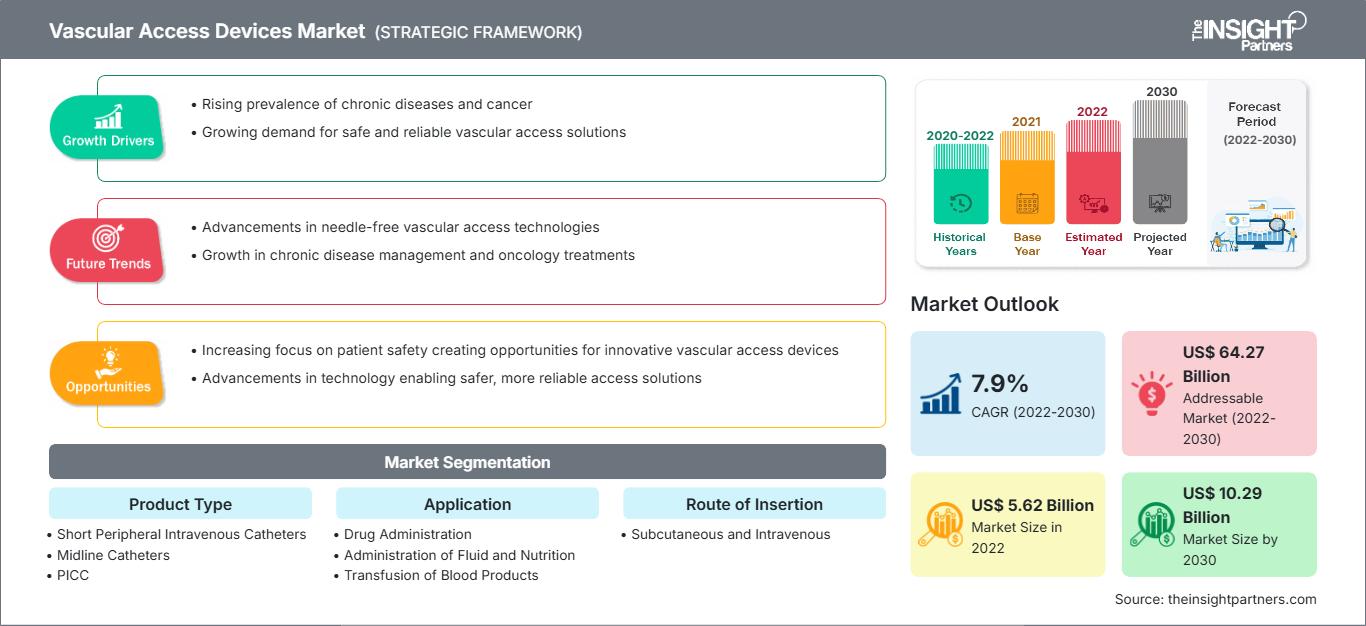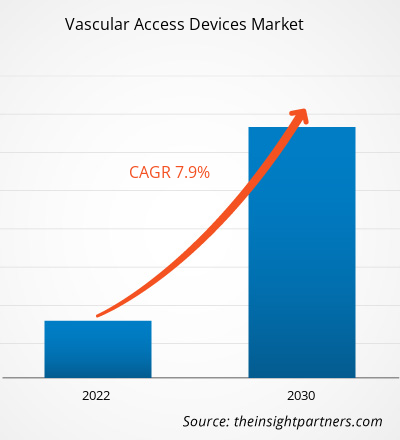[Informe de investigación] El mercado de dispositivos de acceso vascular se valoró en 5.620 millones de dólares estadounidenses en 2022 y se prevé que alcance los 10.290 millones de dólares estadounidenses en 2030. Se espera que registre una tasa de crecimiento anual compuesta (TCAC) del 7,9 % durante el período 2022-2030.
Perspectivas del mercado y opinión de los analistas:
Los dispositivos de acceso vascular se colocan en diversos puntos anatómicos para acceder a la vena cava superior o inferior: vena yugular interna, vena subclavia, vena yugular externa y vena femoral. El creciente mercado de dispositivos de acceso vascular se debe a la mayor prevalencia de enfermedades crónicas y a la creciente necesidad de quimioterapia. Además, las iniciativas estratégicas de las empresas para mantenerse competitivas impulsan este crecimiento. Es probable que un aumento significativo en el uso de dispositivos robóticos de acceso venoso con inteligencia artificial genere nuevas tendencias en el mercado durante el período de pronóstico.
Factores de crecimiento y desafíos:
La quimioterapia es un tratamiento primario o adyuvante que se utiliza para reducir o eliminar tumores mediante la administración de fármacos potentes. Por consiguiente, el aumento de los casos de cáncer impulsa la demanda de quimioterapia. Según estimaciones de la Agencia Internacional para la Investigación del Cáncer (IARC), en 2020 se notificaron 19,3 millones de nuevos casos de cáncer en todo el mundo y se produjeron cerca de 10 millones de muertes a causa de esta enfermedad. De acuerdo con el Registro Nacional de Cáncer (RNC), en Sudáfrica se diagnosticaron aproximadamente 110 000 nuevos casos de cáncer y se registraron más de 56 000 muertes relacionadas con esta enfermedad en 2020. Además, se prevé que la carga de la enfermedad aumente en las próximas décadas, con un estimado de 138 000 y 175 000 nuevos casos de cáncer para 2030 y 2040, respectivamente, mientras que la mortalidad relacionada con el cáncer ascenderá a 73 000 y 94 000 en dichos años. Por lo tanto, la creciente prevalencia del cáncer impulsa el crecimiento del mercado de dispositivos de acceso vascular.
Obtendrá personalización gratuita de cualquier informe, incluyendo partes de este informe, análisis a nivel de país y paquetes de datos de Excel. Además, podrá aprovechar excelentes ofertas y descuentos para empresas emergentes y universidades.
Mercado de dispositivos de acceso vascular: Perspectivas estratégicas

- Obtenga las principales tendencias clave del mercado que se describen en este informe.Esta muestra GRATUITA incluirá análisis de datos, que abarcarán desde tendencias de mercado hasta estimaciones y pronósticos.
Segmentación y alcance del informe:
El análisis del mercado de dispositivos de acceso vascular se ha realizado considerando los siguientes segmentos: tipo de producto, aplicación, vía de inserción, usuario final y geografía. Por tipo de producto, el mercado se segmenta en catéteres intravenosos periféricos cortos, catéteres de línea media, catéteres centrales de inserción periférica (PICC), catéteres centrales, puertos implantables y accesorios. El segmento de catéteres centrales se subdivide en catéteres centrales de inserción central (CICC), catéteres centrales de inserción femoral (FICC) y otros. Según la aplicación, el mercado de dispositivos de acceso vascular se segmenta en administración de fármacos, administración de fluidos y nutrición, transfusión de hemoderivados y otros. Según la vía de inserción, el mercado se divide en subcutánea e intravenosa. Según los usuarios finales, el mercado se segmenta en hospitales y clínicas, centros quirúrgicos ambulatorios y otros. El alcance del informe sobre el mercado de dispositivos de acceso vascular comprende América del Norte (EE. UU., Canadá y México), Europa (España, Reino Unido, Alemania, Francia, Italia y el resto de Europa), Asia Pacífico (Corea del Sur, China, Japón, India, Australia y el resto de Asia Pacífico), Oriente Medio y África (Sudáfrica, Arabia Saudita, Emiratos Árabes Unidos y el resto de Oriente Medio y África) y América del Sur y Central (Brasil, Argentina y el resto de América del Sur y Central).
Análisis segmentario: Analysis:
El mercado de dispositivos de acceso vascular, por tipo de producto, se segmenta en catéteres intravenosos periféricos cortos, catéteres de línea media, catéteres centrales de inserción periférica (PICC), catéteres centrales, puertos implantables y accesorios. El mercado de catéteres centrales se subdivide en catéteres centrales de inserción central (CICC), catéteres centrales de inserción femoral (FICC) y otros. En 2022, el segmento de catéteres intravenosos periféricos cortos representó la mayor cuota de mercado de dispositivos de acceso vascular, y se prevé que este mismo segmento registre la mayor tasa de crecimiento anual compuesto (TCAC) durante el período 2022-2030.
Según su aplicación, el mercado de dispositivos de acceso vascular se segmenta en administración de fármacos, administración de fluidos y nutrición, transfusión de hemoderivados y otros. En 2022, el segmento de administración de fármacos representó la mayor cuota de mercado y se prevé que registre la mayor tasa de crecimiento anual compuesto (TCAC) durante el período 2022-2030.
Según la vía de inserción, el mercado de dispositivos de acceso vascular se divide en subcutáneo e intravenoso. El segmento intravenoso ostentó una mayor cuota de mercado en 2022 y se prevé que registre una mayor tasa de crecimiento anual compuesto (TCAC) durante el período 2022-2030.
Por usuario final, el mercado se segmenta en hospitales y clínicas, centros quirúrgicos ambulatorios y otros. Se prevé que el mercado de dispositivos de acceso vascular para el segmento de hospitales y clínicas crezca durante el período 2022-2030.
Análisis regional:
América del Norte es el principal impulsor del crecimiento del mercado mundial de dispositivos de acceso vascular. Se prevé que Asia Pacífico registre la mayor tasa de crecimiento anual compuesto (TCAC) en el mercado durante el período 2022-2030. América del Norte ostentó la mayor cuota de mercado global en 2022 debido a la creciente prevalencia de enfermedades crónicas, el aumento de la población geriátrica, la presencia de actores clave del mercado involucrados en el desarrollo de productos nuevos y existentes, y los crecientes avances tecnológicos. En América del Norte, Estados Unidos tuvo la mayor cuota de mercado en 2022.
Perspectivas regionales del mercado de dispositivos de acceso vascular
Los analistas de The Insight Partners han explicado en detalle las tendencias regionales y los factores que influyen en el mercado de dispositivos de acceso vascular durante el período de previsión. Esta sección también analiza los segmentos y la geografía del mercado de dispositivos de acceso vascular en Norteamérica, Europa, Asia Pacífico, Oriente Medio y África, y Sudamérica y Centroamérica.
Alcance del informe de mercado de dispositivos de acceso vascular
| Atributo del informe | Detalles |
|---|---|
| Tamaño del mercado en 2022 | 5.620 millones de dólares estadounidenses |
| Tamaño del mercado para 2030 | 10.290 millones de dólares estadounidenses |
| Tasa de crecimiento anual compuesto global (2022 - 2030) | 7,9% |
| Datos históricos | 2020-2022 |
| período de previsión | 2022-2030 |
| Segmentos cubiertos | Por tipo de producto
|
| Regiones y países cubiertos | América del norte
|
| Líderes del mercado y perfiles de empresas clave |
|
Densidad de los participantes en el mercado de dispositivos de acceso vascular: comprensión de su impacto en la dinámica empresarial
El mercado de dispositivos de acceso vascular está creciendo rápidamente, impulsado por la creciente demanda de los usuarios finales debido a factores como la evolución de las preferencias de los consumidores, los avances tecnológicos y una mayor conciencia de los beneficios del producto. A medida que aumenta la demanda, las empresas amplían su oferta, innovan para satisfacer las necesidades de los consumidores y aprovechan las nuevas tendencias, lo que impulsa aún más el crecimiento del mercado.

- Obtenga una visión general de los principales actores del mercado de dispositivos de acceso vascular.
Desarrollos de la industria y oportunidades futuras:
El pronóstico del mercado de dispositivos de acceso vascular se estima a partir de diversos hallazgos de investigación primaria y secundaria, como publicaciones de empresas clave, datos de asociaciones y bases de datos. Según los comunicados de prensa publicados por los principales actores del mercado, a continuación se enumeran algunas estrategias:
- En noviembre de 2023, BD (Becton, Dickinson and Company) lanzó una nueva tecnología de extracción de sangre sin agujas, compatible con catéteres integrados, lo que contribuye a hacer realidad la visión de la compañía de una "Estancia hospitalaria con una sola punción". El dispositivo de extracción de sangre sin agujas PIVO Pro presenta mejoras de diseño para lograr la compatibilidad con catéteres intravenosos periféricos integrados y largos, incluido el nuevo sistema de catéter intravenoso cerrado Nexiva con acceso intravenoso NearPort.
- En mayo de 2023, Teleflex Inc. lanzó dos nuevos dispositivos: el Arrow VPS Rhythm DLX y el NaviCurve Stylet, diseñados para optimizar la inserción del catéter PICC y reducir la probabilidad de complicaciones. El VPS Rhythm DLX proporciona información en tiempo real sobre la ubicación de la punta del catéter mediante el análisis de la actividad eléctrica cardíaca del paciente. El NaviCurve Stylet presenta una curvatura anatómica y una punta flexible diseñadas para autoorientarse a la anatomía del paciente, facilitando así el avance del catéter PICC hacia la vena cava superior (VCS) y logrando una inserción exitosa.
Panorama competitivo y empresas clave:
Teleflex Inc., BD, B. Braun SE, Terumo Medical Corporation, Medtronic, Fresenius Kabi, Baxter, Vygon SAS, Kimal y Access Vascular Inc. figuran entre los principales actores del mercado de dispositivos de acceso vascular analizados en el informe. Además, se estudiaron y analizaron otros actores para obtener una visión integral del mercado y su ecosistema. Estas empresas se centran en la expansión geográfica y el lanzamiento de nuevos productos para satisfacer la creciente demanda de los consumidores en todo el mundo y ampliar su gama de productos especializados. Su presencia global les permite atender a una amplia base de clientes, lo que facilita la expansión del mercado.
- Análisis histórico (2 años), año base, pronóstico (7 años) con CAGR
- Análisis PEST y FODA
- Tamaño del mercado, valor/volumen: global, regional y nacional
- Industria y panorama competitivo
- Conjunto de datos de Excel
Informes recientes
Testimonios
Razón para comprar
- Toma de decisiones informada
- Comprensión de la dinámica del mercado
- Análisis competitivo
- Información sobre clientes
- Pronósticos del mercado
- Mitigación de riesgos
- Planificación estratégica
- Justificación de la inversión
- Identificación de mercados emergentes
- Mejora de las estrategias de marketing
- Impulso de la eficiencia operativa
- Alineación con las tendencias regulatorias




















 Obtenga una muestra gratuita para - Mercado de dispositivos de acceso vascular
Obtenga una muestra gratuita para - Mercado de dispositivos de acceso vascular